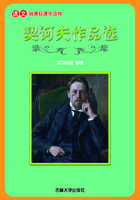The Easter we celebrate today is a combination① of different traditions. Partly, it comes from old festivals to celebrate Spring. And partly it comes from the Christian celebration of the rebirth of Jesus Christ.
Most people agree that the word “Easter” comes from the Anglo Saxon Goddess Eastre, a symbol of Spring. It is easy to see how “Eastre time” became “Easter time”.
As a chief Christian festival, Easter is celebrated on the first Sunday after the first full moon after the 1st day of Spring. It can be as early as March 22, or as late as April 25. Many dates of the Christian calendar are dependent on Easter.
The celebrations of Easter have many customs and legends that have nothing to do with Christianity. Of all the symbols associated with Easter, the egg, the symbol of richness and new life, is the most important. The customs and traditions of using eggs have been associated② with Easter for centuries.
Originally, Easter eggs were painted with bright colors to represent the sunlight of spring and were used in Easter egg rolling contests or given as gifts. After they were colored and printed with various designs, the eggs were exchanged by lovers and romantic admirers. In the Middle Ages, eggs were traditionally③ given at Easter to the servants. In Germany, eggs were given to children along with other Easter gifts.
Different cultures have developed their own ways of decorating④ Easter eggs. Deep red colored eggs, to honor the blood of Christ, are exchanged in Greece. In parts of Germany and Austria green eggs are used on Thursday of the Holy Week.
In Germany and other countries eggs used for cooking were not broken, but the contents were removed by making a hole from the end of each egg with a needle and blowing the contents into a bowl. The hollow eggs were dyed and hung from trees during the Easter Week. The Armenians would decorate hollow eggs with pictures of Christ, the Virgin Mary, and other religious designs.
As with the Easter Rabbit and the holiday itself, the Easter Egg predates⑤ the Christian holiday of Easter. The exchange of eggs in the springtime is a custom that was centuries old when Easter was first celebrated by Christians.
From the earliest times, the egg was a symbol of rebirth in most cultures. Eggs were often wrapped in gold leaf or, if you were a peasant, colored brightly by boiling them with the leaves or petals of certain flowers.
Today, children hunt colored eggs and place them in Easter baskets along with the modern version of real Easter eggs those made of plastic or chocolate candy.
Eggs play an important part in Easter sports. The Romans celebrated the Easter season by running races on an oval track and giving eggs as prizes. Two traditional Easter egg games are the Easter Egg Hunt and the Easter Egg Roll.
On Easter morning, the children of the house join in a search to locate the eggs that the Easter Rabbit had hidden while they were asleep. Sometimes prizes of candy are awaiting the child finding the most eggs.
Easter egg hunts are also part of a community’s celebration of the holiday. The eggs are hidden in public places and the children of the community are invited to find the eggs.
The rules of an Easter Egg Roll are to see who can roll an egg the greatest distance or can make the roll without breaking it, usually down a grassy hillside or slope.
Maybe the most famous egg rolling takes place on the White House Lawn in America. Hundreds of children come with baskets filled with brightly decorated eggs and roll them down the famous lawn, hoping the President of the United States is watching the fun.
① combinationn. 结合体,联合体
② associatev. 联想;把……结合
③ traditionallyadv. 传说上,传统上
④ decoratev. 装饰,修饰
⑤ predatev. 在日期上早于
复活节彩蛋
当今世人所庆祝的复活节实际上融合了多种古老的传统。它一部分来自古老的迎春佳节,一部分源于基督徒纪念耶稣基督复活的仪式。
多数人认为“复活节”一词源于盎格鲁撒克逊人所信奉的女神EASTRE,她是春天的象征。这样,就不难理解“女神EASTRE的节日”如何演变为现今的“EASTER”一词了。
复活节是重要的基督教节日,每年春分(3月21日)过后,第一次月圆后的第一个星期日就是复活节。它的具体时间可早在3月22日,亦可晚至4月25日。基督教教历的许多重要日子都与复活节的具体日期有关。
复活节节庆活动的许多习俗与传说都与基督教无关。在所有与复活节有关的象征性事物中,复活节彩蛋最为重要,它象征着富饶与新生。涉及彩蛋的习俗与传统成为复活节节庆活动的组成部分,已有数百年的历史。
起初,复活节彩蛋被涂上鲜艳的色彩,象征春天的阳光,并被用于滚彩蛋比赛或作为馈赠的礼物。恋人们和迷恋浪漫的人们将彩蛋涂上色彩并绘成各式图案后相互交换。中世纪,主人习惯在复活节时将彩蛋赐予仆人。在德国,大人们将彩蛋连同其它复活节礼物一起送给孩子们。
不同的文化形成了独特的复活节彩蛋装饰方法。在希腊,人们相互交换深红色的彩蛋,以纪念基督为人类付出的鲜血。在德国和奥地利部分地区,人们在复活节前一周的星期四这一天交换绿色的彩蛋。
在德国和其它一些国家,人们在食用鸡蛋时并不事先将其打破,他们往往用针在鸡蛋一头扎一小孔,再将鸡蛋内的蛋液吹进碗中。空蛋壳被染上色彩,到了复活节那一周,就被挂在树上。亚美尼亚人则在空蛋壳外绘上基督、圣母玛丽亚的图像及其它宗教图案。
正如复活节兔子以及复活节本身一样,复活节彩蛋的来历远远早于基督教的复活节节庆日。当基督徒们第一次开始过复活节时,人们在春日里交换彩蛋这种习俗已经有了数百年的历史。
人类文明的早期,大多数文化就将鸡蛋作为新生的象征。人们常用金制的叶子包裹鸡蛋,农夫们则加入树叶或花瓣来煮蛋,将其染上鲜艳的色彩。
现在,孩子们则玩起了找彩蛋的游戏,将其与用塑料或巧克力糖制成的现代版的复活节彩蛋一起放入复活节用的篮子里。
在复活节体育活动中,鸡蛋扮演着重要的角色。罗马人过复活节时,在椭圆形跑道上举行赛跑比赛,胜者得到的奖品就是鸡蛋。寻找彩蛋和滚彩蛋是两项传统的复活节彩蛋游戏。
头天夜里孩子们入睡后,扮作复活节兔子的人事先将彩蛋藏好。复活节当天早晨,屋里的孩子就加入到寻找彩蛋的行列里。哪个孩子找到的彩蛋最多,就有可能得到糖果奖励。
寻找彩蛋也是社区复活节节庆的一部分。人们将彩蛋藏在公共场合,然后邀请社区的孩子们来寻找彩蛋。
滚彩蛋的规则是看谁的彩蛋滚得最远,或看谁能滚动彩蛋而不把它弄破。活动通常在绿草覆盖的小山坡上或斜坡上进行。
在美国,最著名的恐怕要算在白宫草坪上举行的滚彩蛋活动。成百上千的孩子们拎着装有各式鲜艳彩蛋的篮子来到这里,在这块著名的草坪上滚彩蛋,盼望美国总统能看到他们游戏。














